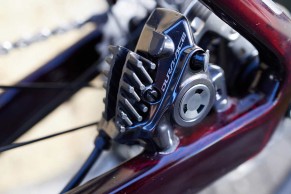Disc brakes vs rim brakes for road bikes, what do you need to know in 2022?
With almost a decade on the market, disc brakes have established themselves in the road bike range. The fierce debate about their necessity or the brands' motives for their introduction has faded. Despite all this, many still defend the simplicity and effectiveness of rim brakes.

Are disc brakes really better than rim brakes?
Almost 10 years after the introduction of disc brakes on the road bike market, we can have enough perspective to decide whether this system has really meant an evolution in road bikes compared to the traditional rim brakes, whose evolution had made them powerful and modular.
In any case, brands and groupset manufacturers have decided that the future belongs to discs, and despite whoever it may be, it is increasingly difficult to find new bikes with rim brakes, even in the lower ranges.
The advantages of disc brakes
RECOMENDADO

10 tips for safer and faster downhills on road bikes

The best gravel groupsets of the moment

How to lose body fat? Differences between losing weight and losing fat

Cycling sunglasses on the outside or inside the helmet?

When must the tubeless tire sealant be replaced? What quantity?

The real importance of signing up for a race
Despite all the time they have been on the market, many are still unclear about the real innovations brought about by the introduction of disc brakes and are left with a generic "they brake more".
A statement that is not really true since the maximum braking power is determined by the grip of the tyre and not by the power offered by the brakes which, at a gross level, is not much higher than that provided by the latest models of rim brakes available.
The main idea of disc brakes is to have a system dedicated exclusively to the task of stopping the bike and not to leave the responsibility of transforming kinetic energy into heat to the rim of the bike, which is also a structural part of the wheel and also has the task of holding the bike tyre in place by resisting the pressure of the air inside it.

Another feature is the hydraulic actuation of the disc brakes as opposed to the cables of the rim brakes, a way of acting that instantly transmits the force we exert on the lever to the brake pads without the need to exert a great deal of effort. This has made it possible to brake from the top of the levers as efficiently as from the bottom, greatly reducing the strain on the rider.
The direct feel of the hydraulic system, with a much more linear behaviour than the cables of the rim brakes, allows easier modulation of the power applied at any given moment, making braking more effective by being able to apply more power without fear of locking the wheel or even braking in the middle of a corner without fear of losing grip.
Finally, we must not forget the ability to brake when rain makes its appearance, which in disc brakes remains practically unchanged, unlike what happened with rim brakes whose rubber was mercilessly devoured by braking when water got in the way, as well as tremendously reducing efficiency.
How bikes have changed
For many, the aesthetics of a road bike with disc brakes is a real horror. These are simply personal opinions for those who have had a bike concept all their lives. In reality, the aesthetics haven't changed that much over the years, apart from the larger sections in the chainstays and fork legs in order to achieve sufficient robustness to support the torsion produced by braking and the necessary lateral stiffness to avoid rubbing.
The main effect of disc brakes on the bikes is not visually palpable, but it translates into an increase in weight which, although not excessive on its own, has to be added to a more robust wheelset. Although we can find bikes with disc brakes on the market that are really light, in general the weight of the bikes has increased, not only because of the discs, but also because of the standardisation of aerodynamic tube sections and internal cable routing, so that nowadays it is difficult to find bikes that are close to the UCI limit of 6.8 kg.

Disc brakes have made it possible to eliminate the main limitation to the wheel arches, so another of the changes has been the normalisation of the use of wider rims and tyres with more balloon, starting to normalise the 28 mm size, which not so long ago was used by the professionals to tackle the pavé classics.
And speaking of tyres, it is also worth mentioning that disc brakes have been a relief for wheel manufacturers who had to invest significant resources to achieve reliability in carbon models for rim brakes as overheating caused by braking was for a time a serious reliability problem for this type of wheel.
The problems with disc brakes
Although disc brake systems have evolved over the years to make the calipers more minimalist or to integrate the anchoring to the bike with the incorporation of the flat mount system or to make bleeding tasks easier, there are still some drawbacks that are still being used by the detractors of disc brakes.
The friction of the pads against the disc is still the main criticism that many make of disc brakes, forgetting that it was also common with rim brakes and that it forced many to open the lever on the brakes to separate them and remove the wheel. A problem that Shimano has tried to put a stop to in its latest groupsets, but which, even so, is still a headache for many.

In general, the maintenance of disc brakes is the most frightening thing for most people. Adjusting the calipers to avoid friction is not as trivial as it was for rim brakes and already bleeding the brakes is for many a science fiction process. However, the reality is that once the correct adjustment has been achieved, disc brakes hardly need any attention for a long period of time.
In this section we have to refer to one of the problems that many predicted but which did not come to pass: that of crashes in the peloton. There was talk that the discs were going to cause cuts and burns in each bunch. Some cases came out claiming that the disc brakes were responsible for the cuts. Incidents that in many cases have ended up proving to have been caused by another part of the bike, such as the chainrings.
Are disc brakes better than rim brakes?
As in all aspects of life, it depends. Mainly on the technical level of the rider. Someone with a good mastery of the bike is capable of descending just as quickly and safely with rim brakes as with disc brakes. We have to bear in mind that rim brakes had already achieved a tremendous level of modulability and effectiveness before they were ousted by the brands' commitment to disc brakes.

Those who will appreciate the feel and almost effortless braking ability of disc brakes are those less skilled on the bike and those who are afraid of downhills. A fear that is often generated by the feeling that one will not be able to stop and control the bike when the speed increases. The efficiency of disc brakes has been like a breath of fresh air for these riders who have suddenly found the confidence to stop suffering on downhills.
As we said at the beginning, after all these years on the market there is no going back and little by little the bikes with rim brakes will start to acquire the aura of classic bikes that, for example, those with the gear levers on the down tube have. What do you think of disc brakes, are you happy with how they work and how would you improve them? Tell us about it on our social networks!